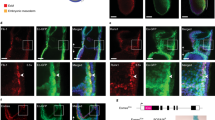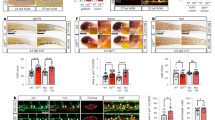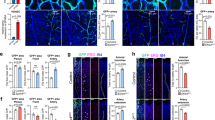Abstract
THE receptor tyrosine kinase Flk-1 (ref. 1) is believed to play a pivotal role in endothelial development. Expression of the Flk-1 receptor is restricted to endothelial cells and their embryonic precursors2–5, and is complementary to that of its ligand, vascular endothelial growth factor (VEGF)2,3, which is an endothelial-speci-fic mitogen6. Highest levels of flk-1 expression are observed during embryonic vasculogenesis and angiogenesis2–5, and during pathological processes associated with neovascularization, such as tumour angiogenesis7,8. Because flk-1 expression can be detected in presumptive mesodermal yolk-sac blood-island progenitors as early as 7.0 days postcoitum, Flk-1 may mark the putative common embryonic endothelial and haematopoietic precursor, the haemangioblast, and thus may also be involved in early haematopoiesis4. Here we report the generation of mice deficient in Flk-1 by disruption of the gene using homologous recombination in embryonic stem (ES) cells. Embryos homozygous for this mutation die in utero between 8.5 and 9.5 days post-coitum, as a result of an early defect in the development of haematopoietic and endothelial cells. Yolk-sac blood islands were absent at 7.5 days, organized blood vessels could not be observed in the embryo or yolk sac at any stage, and haematopoietic progenitors were severely reduced. These results indicate that Flk-1 is essential for yolk-sac blood-island formation and vasculogenesis in the mouse embryo.
This is a preview of subscription content, access via your institution
Access options
Subscribe to this journal
Receive 51 print issues and online access
$199.00 per year
only $3.90 per issue
Buy this article
- Purchase on SpringerLink
- Instant access to full article PDF
Prices may be subject to local taxes which are calculated during checkout
Similar content being viewed by others
References
Mathews, W. et al. Proc. natn. Acad. Sci. U.S.A. 88, 9026–9030 (1991).
Millauer, B. et al. Cell, 72, 1–12 (1993).
Quinn, T. P., Peters, K. G., De Vries, C., Ferrara, N. & Williams, L. T. Proc. natn. Acad. Sci. U.S.A. 90, 7533–7537 (1993).
Yamaguchi, T. P., Dumont, D. J., Conlon, R. A., Breitman, M. L. & Rossant, J. Development 118, 489–498 (1993).
Oelrichs, R. B., Hugh, R. H., Bernard, O., Ziemiecki, A. & Wilks, A. F. Oncogene 8, 11–15 (1993).
Ferrara, N. & Henzel, W. J. Biochem. biophys. Res. Commun. 161, 851–858 (1989).
Plate, K. H., Breier, G., Millauer, B., Ullrich, A. & Risau, W. Cancer Res. 53, 5822–5827 (1993).
Millauer, B., Shawver, L. K., Plate, K. H., Risau, W. & Ullrich, A. Nature 367, 576–579 (1994).
Kaipainen, A. et al. Proc. natn. Acad. Sci. U.S.A. (in the press).
Dumont, D. J., Yamaguchi, T. P., Conlon, R. A., Rossant, J. & Breitman, M. L. Oncogene 7, 1471–1480 (1992).
Dumont, D. J. et al. Devl Dynam. 203, 80–92 (1995).
Korhonen, J., Polvi, A., Partanen, J. & Alitalo, K. Oncogene 9, 395–403 (1994).
Brotherton, T. W., Chui, D. H., Gauldie, J. & Patterson, M. Proc. natn. Acad. Sci. U.S.A. 76, 2853–2857 (1979).
Tsai, F. et al. Nature 339, 446–451 (1989).
Weiss, M. J., Keller, G. & Orkin, S. H. Genes Dev. 8, 1184–1197 (1994).
Zipori, D. & Lee, F. Blood 71, 586–596 (1988).
Young, P. E., Baumhueter, S. & Lasky, L. A. Blood 85, 96–101 (1995).
Noden, D. M. Am. Rev. resp. Dis. 140, 1097–1103 (1989).
Medvinsky, A. L., Samoylina, N. L., Muller, A. M. & Dziersak, E. A. Nature 364, 64–67 (1993).
Godin, I. E., Garcia-Porrero, J. A., Coutinho, A., Dieterlen-Lievre, F. & Marcos, M. A. R. Nature 364, 67–70 (1993).
Wagner, R. C. Adv. Microcirc. 9, 45–75 (1980).
Shibuya, M. et al. Oncogene 5, 519–524 (1990).
Fong, G.-H., Rossant, J., Gertsenstein, M. & Breitman, M. L. Nature 376, 66–70 (1995).
Wong, P. M., Chung, S. W., Chui, C. H. & Eaves, C. J. Proc. natn. Acad. Sci. U.S.A. 83, 3851–3854 (1986).
Sambrook, J., Fritsch, E. F. & Maniatis, T. Molecular Cloning, a Laboratory Manual 2nd edn (Cold Spring Harbour Laboratory Press, New York, 1989).
Tybulewicz, V. L. J., Crawford, C. E., Jackson, P. K., Bronson, R. T. & Mulligan, R. C. Cell 65, 1153–1163 (1991).
Nagy, A., Rossant, J., Nagy, R., Abramow-Newerly, W. & Roder, J. C. Proc. natn. Acad. Sci. U.S.A. 90, 8424–8428 (1993).
Wurst, W. & Joyner, A. L. in Gene Targeting 33–61 (Oxford Univ. Press, New York, 1993).
Iwama, A. et al. Biochem. biophys. Res. Commun. 195, 301–309 (1993).
Keller, G., Kennedy, M., Papayannopoulou, T. & Wiles, M. Molec. cell. Biol. 13, 473–486 (1993).
McClanahan, T., Dalrymple, S., Barkett, M. & Lee, F. Blood 81, 2903–2915 (1993).
Author information
Authors and Affiliations
Rights and permissions
About this article
Cite this article
Shalaby, F., Rossant, J., Yamaguchi, T. et al. Failure of blood-island formation and vasculogenesis in Flk-1-deficient mice. Nature 376, 62–66 (1995). https://doi.org/10.1038/376062a0
Received:
Accepted:
Issue Date:
DOI: https://doi.org/10.1038/376062a0



